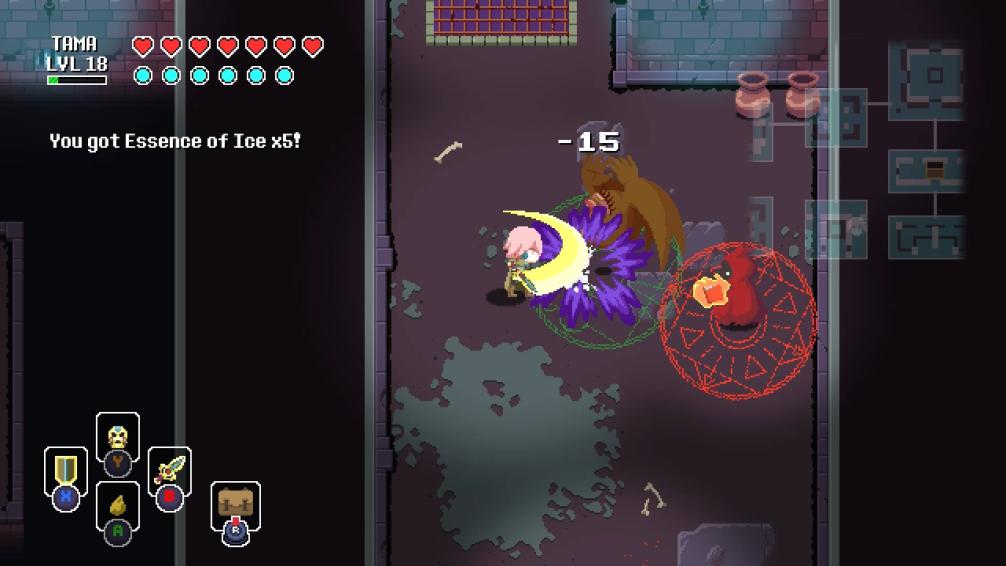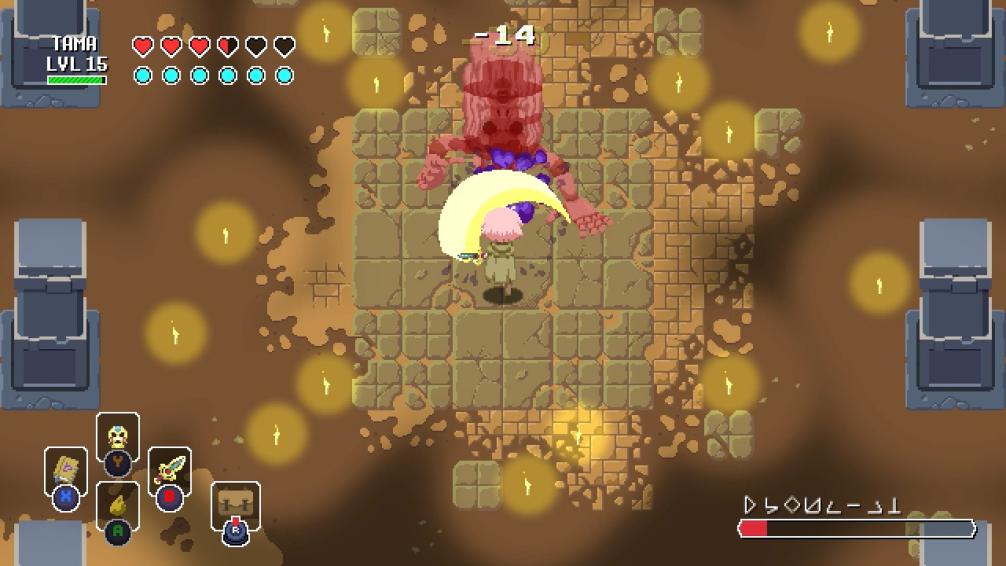Search
[{{{type}}}] {{{reason}}}
{{/data.error.root_cause}}{{{_source.title}}} {{#_source.showPrice}} {{{_source.displayPrice}}} {{/_source.showPrice}}
{{#_source.showLink}} {{/_source.showLink}} {{#_source.showDate}}{{{_source.displayDate}}}
{{/_source.showDate}}{{{_source.description}}}
{{#_source.additionalInfo}}{{#_source.additionalFields}} {{#title}} {{{label}}}: {{{title}}} {{/title}} {{/_source.additionalFields}}
{{/_source.additionalInfo}}Sword of the Necromancer (PC)

Sword of the Necromancer
Developed By: Grimorio of Games
Published By: JanduSoft, Game Seer Ventures
Released: January 29, 2021
Available On: Windows, Xbox One, XSX, Switch, PS4
Genre: Action RPG
ESRB Rating: M for Mature 17+ (Blood, Strong Language, Suggestive Themes, Violence)
Number of Players: Single-player
Price: $14.99
Thanks to Grimorio of Games for sending us a review copy!
Sword of the Necromancer (SotN) is an Action RPG from Grimorio of Games, with a splash of roguelike mechanics. First spruiked on Kickstarter, it met with a small delay as it tried to avoid being overshadowed by the release of the most anticipated game of the year, ultimately releasing a mere two months late at the start of 2021.
The story opens with Koko laid upon an Altar. As the heroine Tama, you must first retrieve the titular Sword of the Necromancer, and then navigate through a dungeon as you seek the power to resurrect Koko from the dead. Reaching each floor of a dungeon for the first time is punctuated by a flashback that explains how Koko and Tama met, and how their relationship grows. It’s a classic tale of going to great lengths to resurrect a beloved, as old as Orpheus and Eurydice, and it certainly has the ability to tug gently on the heartstrings. Something that must be noted here is that the writing takes on the style of a B-anime, right down to the cliché lines, and is presented much like a Visual Novel.
According to the game’s Kickstarter project, the gameplay draws inspiration from games such as Enter the Gungeon and A Link to the Past, but in practice it feels a lot closer to Hyper Light Drifter. A controller is highly recommended to explore the procedurally-generated dungeons. Each of the face buttons attacks with whatever weapon has been assigned to it, and holding will charge the next attack. The triggers will expend some of your regenerating soul points to dodge or dash. Unlike most executions of this mechanic, dodge-cancelling an attack only works on the last hit of a combo, which means that attacks demand commitment. Efficient attack chains involve dodging to reset into the next combo faster. Clicking the thumbsticks opens up your pack, although wrangling new items into the pack is cumbersome. Combat eventually gets dull as it’s a formula that’s been done to death in many games, and all the various weapons with their differences don’t help alleviate this problem.

Strong Points: Rediscover forgotten places with the soundtrack; anime-tier voice acting
Weak Points: Permadeath mechanic works against narrative elements and Forge system; shallow core gameplay; anime-tier voice acting
Moral Warnings: Monster killing and corpses; every swear word; sexual innuendo; same-sex relationship; barely-covered sex scene; player use of necromancy; rejection of cultural norms; misrepresents church history
The various slimes, skeletons, and spirits leave behind experience and valuable corpses on death. These corpses can be picked up in one of your item slots, and then summoned as a minion using soul points. The most effective form of combat is to rely heavily on minions as they deal more damage and are expendable. Even with many experience levels, minions continue to play an important role. This sounds fun on paper, but in practice it means taking a backseat to the action. SotN doesn’t want you to play the hero. You are the supporting act, constantly creating new minions to fuel your undead army and sneaking in hits on distracted enemies. If you’re the sort of RPG player that builds a character with summons and auras, this is sure to appeal. In the second run through the dungeon, you have the option of ditching these necromantic powers, and doing so exposes just how dull the core combat loop is.
Upon death, you’ll lose all your items and half your experience levels and be returned to the Altar area. Here you can check your encyclopedia, read snippets of lore, stash items in the Chest, or Forge your equipment using materials found in the dungeon to provide bigger and better enchantments. I found the Dash Save enchantment to be extremely useful just for the ability to move across the map quickly. Masochists can also enchant their equipment with penalties for an even harder game. The chest also has an IR Scan feature, and offers free items for inputting various codes, but every attempt resulted in a crash to desktop. (Grimorio of Games has since fixed this bug.)
The Forge is a little confusing in terms of its role in this game. The plainer enchantments are cheap and affordable, but all the more potent enchantments of note are a significant investment requiring rare ingredients. The cost of Forging begets a feeling of investment, but permadeath mechanics inherently discourage that investment. And on that note, the story feels excessive. Games with permadeath normally keep their story straight and to a bare minimum of emotion. SotN is an object lesson on why. Having to constantly start over again is not conducive to a story that demands emotional investment. These opposing demands of investment and detachment were a source of frustration. The game comes with options to disable the various permadeath elements in the game, and I highly recommend this until you complete the story. Leave permadeath to the post-game, which should take around five hours.
Visually, the art-style is forgettable, although not in an entirely bad way. The unblackened soft edges on sprites lends a “forgotten places” aesthetic of the dungeon. Every floor uses the same generic dungeon walls environment with a change of color. The retro-style sound effects are a decent match with the visuals, but some of the elemental damage sounds seem like a poor fit when it sounds like something out of steampunk. The soundtrack is really something special though, in my opinion. Every piece carries the “forgotten places” theme in its melody, and you’ll be treated to a wide variety of them. Lost temples, lost caves, lost jungles, lost love, and last chances. It’s no Corridors of Time, but the soundtrack certainly channels the energy of that classic piece. I did have one annoyance with the soundtrack though, namely that transitions between combat and exploration tracks are noticeably abrupt. Story flashbacks are also voiced in English and Japanese. True to the Kickstarter’s “anime opening” stretch goal, the voicework sounds like an anime dubbed in the corresponding language. Whether that’s a good or bad thing will probably match your expectations.

Higher is better
(10/10 is perfect)
Game Score - 68%
Gameplay – 11/20
Graphics – 7/10
Sound – 7/10
Stability – 5/5
Controls – 4/5
Morality Score - 42%
Violence – 6/10
Language – 4/10
Sexual Content – 1/10
Occult/Supernatural – 2/10
Cultural/Moral/Ethical – 8/10
- Mischaracterizes church history
To the morals now, and no stone is left unturned in this examination of SotN’s degeneracy. There is of course plenty of monster killing, and bodies persist for the necromancy mechanics to make use of them. Tama uses every bit of foul language in the book in her flashbacks, and while nothing explicit is said, there is some sexual innuendo. Tama and Koko are both women, and their outlines in the dark through a sheer film of cloth make clear that they’re engaging in what Leviticus 18:22 calls “abominable relations,” and it’s also a rebellion against the cultural norms of the setting. A threat of rape is implied. The presence of necromancy is of course an example of the occult, and the game essentially demands the player engage in the craft. One cutscene also shows the heroines getting wasted on alcohol. Finally, the core questline of reviving Koko from the dead is acknowledged by all, including the final boss, to be a violation of the natural law.
That’s not all though. Koko is a priestess of the church of Nodam, which appears to be modelled faintly on real-life Christianity. The Nodam stories that are shared and the basic values we are told of are sufficiently Christian in appearance to fool a casual observer. This wouldn’t be worth mentioning but for the fact that it seems like the church of Nodam is meant to be a stab at Christianity. Koko the priestess mentions the book of Nodam having no instructions on homosexuality, explains that it is merely a book of laws rather than a manual for life, and insists that the church of Nodam does nothing good for the poor and weary. Koko is given credit as a single person working apart from the church for bringing education and scientific advancement to the masses. But in the real world, it was actually the church that brought education to the masses, it was the church that was responsible for setting up various infrastructures, and it is the church that was responsible for advancing the sciences well into the 1800s before state governments and private enterprises began to see the value in all these things as a common good available to the peasantry. The assignment of credit to a single character is understandable for storytelling purposes, but this is still a pseudo-revisionist story that mischaracterises the historical contributions that the church has made to the world.
Sword of the Necromancer brings together a set of disparate systems and makes them play together without concern for whether it should make them play together. Even putting aside the gratuitous moral concerns, this game seems like a hard sell when compared to the far more capable Hyper Light Drifter. It’s a game that might have been better served by focusing on the fun, rather than falling prey to feature bloat.








